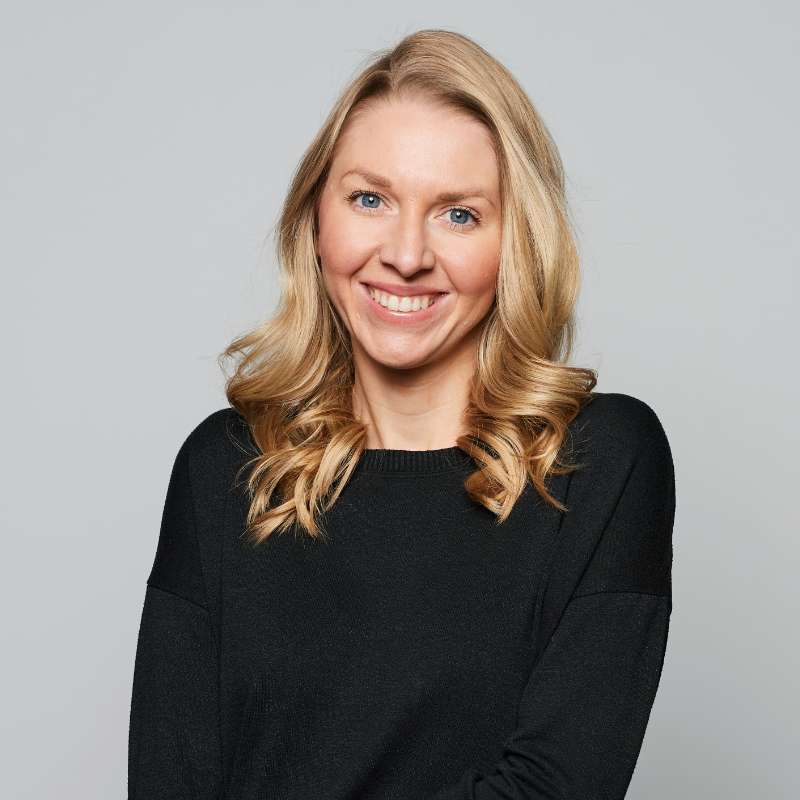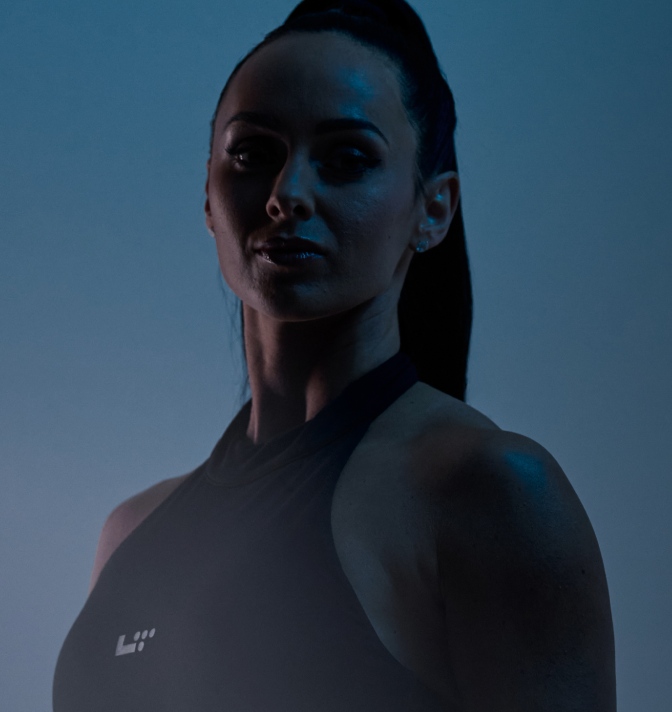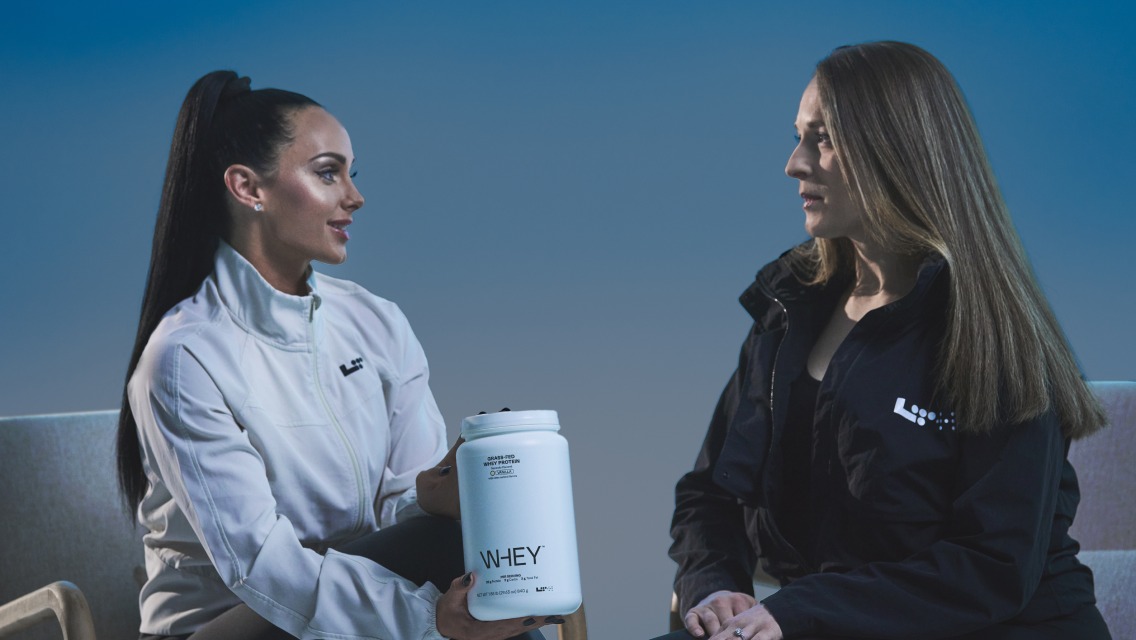With the volume of training programs available nowadays and the number of fitness influencers posting their workouts on social media, there are a few questions that are fair to ask: How did they come up with this workout or program? What is the intended outcome? Has that outcome been proven?
The frustrations with this is just one of the reasons Coach Hayley Akradi, CPT, who’s been training members at Life Time for more than a decade, created her new digital training program, The Body Blueprint. After years of honing in on the strength-training methods that resulted in real change in her body, she mapped them out into this program so that others could benefit from the same demonstrated approach.
“I think it’s frustrating for people who see somebody on Instagram and say, I want to train like them so I can look like they do. And then they go to their link in bio and buy, say, a three-day booty-building program that was designed to put money in their pocket — not as something they actually do,” Akradi says. “The Body Blueprint is my program. In this moment, I’m on week five of it. It is quite literally how I train to live my life.”
We spoke with Akradi to learn more about The Body Blueprint program and how it’s informed by her personal approach to health and fitness.
Life Time | Your personal experiences have influenced your philosophies around fitness and health. Can you tell us about your approach and how that came to be?
Hayley Akradi | In 2010, I graduated high school and got my first membership at Life Time, and that is when I really discovered strength training. I was taking yoga and strength group classes, as well as some Alpha classes. I started to understand how I could manipulate my body with different training techniques. About five or six years later, I decided I was going to hire a coach and go into the sport of bodybuilding.
But things took a little bit of a turn when I took a trip to Mexico and got salmonella. I was very, very sick, but I got back to the United States, received treatment, and thought I was getting better until I started experiencing pain in my right leg. I knew it wasn’t an injury, but was told it was by a doctor and sent home from their office.
The pain got worse and worse and I had so much swelling I couldn’t get my pants on anymore. It felt like there were knives floating in my leg. Anytime I would move or breathe, there was so much pain. I checked myself into the ER and they did a bunch of tests, but told me I was fine and sent me home.
I ended up getting stuck in my closet because I couldn’t move off the floor. I checked myself into the ER again and was admitted to the hospital. Over three days I saw about six doctors and ended up being sent home again without them figuring out the cause.
Six months went by where I couldn’t walk without crutches. All the muscle I had built had completely atrophied. I ended up being seen at the Mayo Clinic where I finally got answers: I was diagnosed with an autoimmune condition caused by a gene called HLA-B27. It’s a reactive arthritis you can get based off of one of three different infections — one of them being salmonella.
I saw a rheumatologist who recommended intense medication which came with a multitude of negative implications, and so I decided to go the holistic route. I found an amazing holistic doctor who I still see to this day and we worked on ridding my body of inflammation through diet and other lifestyle practices. Within two weeks, I was on the training floor again.
I didn’t have any muscle left by this point, but I started over. I got back into bodybuilding and made it to the national level.
That takes us to about 2018, which is when I realized the stress I was putting on my body related to my bodybuilding efforts was causing my autoimmunity to become out of control. So, I started training in a new way — still to manipulate my body, but without so much cardio and output, and without my cortisol levels going through the roof. I was training in a way that let my body calm between sessions.
This is a long story, but this is how The Body Blueprint program came to be — I took all the different pieces I loved from training and put them together in a way that wouldn’t stress my body. The way I train, the things I do before, between, and after training, it all comes from a very holistic approach.
LT | The Body Blueprint program is designed to build strength and hypertrophy without overstressing the body, which is very intentional. Tell us more about the program — what outcomes can someone expect from it and who’s it best for?
HA | I’m excited for people to go through The Body Blueprint and have the same experience and outcomes from it that I have. I called it the “blueprint” because it is quite literally the blueprint of how I train every single day. It’s an eight-week program available to anyone in the Life Time app.
The goal is to build strength and muscle while also being able to burn fat and improve your body composition. It’s not a weight-loss program; it’s a program where your muscle comes up and your body fat goes down. You can expect to look and feel different in your body.
I would say it’s for intermediate and above levels because it is important to have a foundation for how to properly move in weightlifting exercises. But for beginners who want to get into this, I have a lot of videos and notes in the program where I coach you through and help explain what movements should look like.
I also love this program because when you’re done with week eight, you can go back to week one and do it again — and keep continuing to get stronger.
I’m excited for people to discover a different way of strength training that’s going to help them get to where they want to be with their body composition but without overtraining and being overstimulated. These workouts help you for life — they don’t put you over the edge.
LT | How is The Body Blueprint laid out and what does a week of exercise look like?
HA | The Body Blueprint is a mix of strength and hypertrophy. It’s not done in phases, but rather combines the two. Each week includes five strength-training days, along with a sixth full-body training day. It’s structured as follows:
- Shoulders and core day
- Quad-based lower-body day
- Glute- and hamstring-focused lower-body day
- Back and biceps day
- Chest and triceps day
- Full-body day
Each day features a primary movement. For example, on shoulders and core day, you’ll perform an overhead press. While that movement stays consistent throughout the eight weeks, variables like sets, reps, and volume will change. The main move is complemented by accessory movements, which you’ll perform as supersets, triple sets, isometric holds, and eccentric movements throughout the course of the program.
While time for recovery is built into the program, the full-body day is optional if you’re ever feeling taxed.
LT | How does recovery look in your personal exercise routine?
HA | I absolutely have off days where I’m not working out — but that doesn’t mean I’m not moving. NEAT (non-exercise activity thermogenesis) is super important. There’s usually a day where I’m coaching Ultra Fit. One day I week, I take my baby, Daria, to gymnastics. Those days movement looks different, but I’m still moving. The days when I’m training harder are usually the days when I’m in the office and sitting more.
You want to make sure you’re thinking about recovery and have a couple of days where you’re not working out super excessively. I also do a Dynamic Stretch session once per week and I love the infrared sauna for recovery too.
LT | Are there certain health and fitness habits that are non-negotiables for you?
HA | I always eat before training and never work out fasted because for me, I’m always reaching for MMF, or momentary muscle failure, which is something we talk about in the program — but having the energy to lift that heavy requires me to get protein and carbs in prior in the morning. I’m usually getting about 30 to 40 grams of protein and 40 grams of carbs. My morning routine is very much the same: I drink electrolytes right away, then I eat, then I caffeinate, and then I lift.
I also always come into the club with a plan for my workouts, and I schedule them on my calendar. I know that every Monday is my shoulders and core day. I know every Wednesday is my quad-based leg day. I put those on my calendar and always show up for myself.
Sleep is also a huge priority for me. I have a baby at home — I need energy for her and I need energy for my workouts. I also need to be recovered. I sleep seven-and-a-half to eight hours every night. My 20-month-old wakes up at 5:15 a.m., so that means I’m getting ready to lay down and fall asleep by 8:30 or 9 p.m. (Learn more: “Coach Hayley Akradi’s Sleep Secrets for Better Health and Performance“)
I eat non-inflammatory foods 80 percent of the time. I don’t eat seed oils. I don’t eat really anything with added ingredients. I try to eat as much from the ground — such as grass-fed beef, organic chicken, fruits, and vegetables — as I can. (Learn more: “How Coach Hayley Akradi Hits Her Daily Protein Goals.”)
LT | What advice would you give to those who are trying to figure out the training program that’s right for them?
HA | I would encourage looking at what you can be successful at and sustainable with. What I mean by that is, if you have three days to work out and you choose a six-day-a-week program, you’re probably not going to be successful at it and you’re probably not going to sustain it. If you’re that person and you want to work out six days a week, you can absolutely get there, but first, you need to feel like you’re successful at something.
The Body Blueprint is a six-day-a-week program so it’s something you do have to put a little bit more time into — but you are absolutely going to see body composition change. As long as you can sustain it and feel successful at it, then it’s the right program for you.
LT | I’m interested! How can I sign up for The Body Blueprint?
HA | The Body Blueprint can be found in the Life Time app. It’s available to anyone who has the app, regardless if you’re a Life Time member of not.





